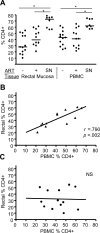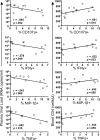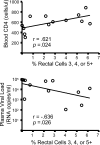Magnitude and complexity of rectal mucosa HIV-1-specific CD8+ T-cell responses during chronic infection reflect clinical status
- PMID: 18974782
- PMCID: PMC2570490
- DOI: 10.1371/journal.pone.0003577
Magnitude and complexity of rectal mucosa HIV-1-specific CD8+ T-cell responses during chronic infection reflect clinical status
Abstract
Background: The intestinal mucosa displays robust virus replication and pronounced CD4+ T-cell loss during acute human immunodeficiency virus type 1 (HIV-1) infection. The ability of HIV-specific CD8+ T-cells to modulate disease course has prompted intensive study, yet the significance of virus-specific CD8+ T-cells in mucosal sites remains unclear.
Methods and findings: We evaluated five distinct effector functions of HIVgag-specific CD8+ T-cells in rectal mucosa and blood, individually and in combination, in relationship to clinical status and antiretroviral therapy (ART). In subjects not on ART, the percentage of rectal Gag-specific CD8+ T-cells capable of 3, 4 or 5 simultaneous effector functions was significantly related to blood CD4 count and inversely related to plasma viral load (PVL) (p<0.05). Polyfunctional rectal CD8+ T-cells expressed higher levels of MIP-1beta and CD107a on a per cell basis than mono- or bifunctional cells. The production of TNFalpha, IFN-gamma, and CD107a by Gag-specific rectal CD8+ T-cells each correlated inversely (p<0.05) with PVL, and MIP-1beta expression revealed a similar trend. CD107a and IFN-gamma production were positively related to blood CD4 count (p<0.05), with MIP-1beta showing a similar trend. IL-2 production by rectal CD8+ T-cells was highly variable and generally low, and showed no relationship to viral load or blood CD4 count.
Conclusions: The polyfunctionality of rectal Gag-specific CD8+ T-cells appears to be related to blood CD4 count and inversely related to PVL. The extent to which these associations reflect causality remains to be determined; nevertheless, our data suggest a potentially important role for mucosal T-cells in limiting virus replication during chronic infection.
Conflict of interest statement
Figures








Similar articles
-
Multifunctional human immunodeficiency virus (HIV) gag-specific CD8+ T-cell responses in rectal mucosa and peripheral blood mononuclear cells during chronic HIV type 1 infection.J Virol. 2007 Jun;81(11):5460-71. doi: 10.1128/JVI.02535-06. Epub 2007 Mar 7. J Virol. 2007. PMID: 17344302 Free PMC article.
-
Antiretroviral therapy-induced dominant interleukin-2 HIV-1 Gag CD4+ T cell response: evidence of functional recovery of HIV-1-specific CD4+ T cells.Scand J Immunol. 2011 Mar;73(3):256-65. doi: 10.1111/j.1365-3083.2010.02502.x. Scand J Immunol. 2011. PMID: 21204901
-
Positive association between beta-chemokine-producing T cells and HIV type 1 viral load in HIV-infected subjects in Abidjan, Côte d'Ivoire.AIDS Res Hum Retroviruses. 2002 Feb 10;18(3):171-7. doi: 10.1089/08892220252781220. AIDS Res Hum Retroviruses. 2002. PMID: 11839151
-
Harnessing CD8+ T Cells Under HIV Antiretroviral Therapy.Front Immunol. 2019 Feb 26;10:291. doi: 10.3389/fimmu.2019.00291. eCollection 2019. Front Immunol. 2019. PMID: 30863403 Free PMC article. Review.
-
Preserving HIV-specific T cell responses: does timing of antiretroviral therapy help?Curr Opin HIV AIDS. 2015 Jan;10(1):55-60. doi: 10.1097/COH.0000000000000124. Curr Opin HIV AIDS. 2015. PMID: 25389805 Free PMC article. Review.
Cited by
-
Incomplete normalization of regulatory t-cell frequency in the gut mucosa of Colombian HIV-infected patients receiving long-term antiretroviral treatment.PLoS One. 2013 Aug 15;8(8):e71062. doi: 10.1371/journal.pone.0071062. eCollection 2013. PLoS One. 2013. PMID: 23967152 Free PMC article.
-
Measurements of immune responses for establishing correlates of vaccine protection against HIV.AIDS Res Hum Retroviruses. 2012 Jul;28(7):641-8. doi: 10.1089/AID.2011.0239. Epub 2011 Sep 23. AIDS Res Hum Retroviruses. 2012. PMID: 21861777 Free PMC article.
-
Predominance of weakly cytotoxic, T-betLowEomesNeg CD8+ T-cells in human gastrointestinal mucosa: implications for HIV infection.Mucosal Immunol. 2017 Jul;10(4):1008-1020. doi: 10.1038/mi.2016.100. Epub 2016 Nov 9. Mucosal Immunol. 2017. PMID: 27827375 Free PMC article.
-
CD8(+)T-cell-mediated control of HIV-1 and SIV infection.Immunol Res. 2011 Apr;49(1-3):135-46. doi: 10.1007/s12026-010-8177-7. Immunol Res. 2011. PMID: 21170741 Free PMC article. Review.
-
Immune responses to HIV and SIV in mucosal tissues: 'location, location, location'.Curr Opin HIV AIDS. 2010 Mar;5(2):128-34. doi: 10.1097/COH.0b013e328335c178. Curr Opin HIV AIDS. 2010. PMID: 20543589 Free PMC article. Review.
References
-
- Borrow P, Lewicki H, Wei X, Horwitz MS, Peffer N, et al. Antiviral pressure exerted by HIV-1-specific cytotoxic T lymphocytes (CTLs) during primary infection demonstrated by rapid selection of CTL escape virus. Nat Med. 1997;3:205–211. - PubMed
-
- Ogg GS, Jin X, Bonhoeffer S, Dunbar PR, Nowak MA, et al. Quantitation of HIV-1-specific cytotoxic T lymphocytes and plasma load of viral RNA. Science. 1998;279:2103–2106. - PubMed
Publication types
MeSH terms
Substances
Grants and funding
LinkOut - more resources
Full Text Sources
Other Literature Sources
Medical
Research Materials

